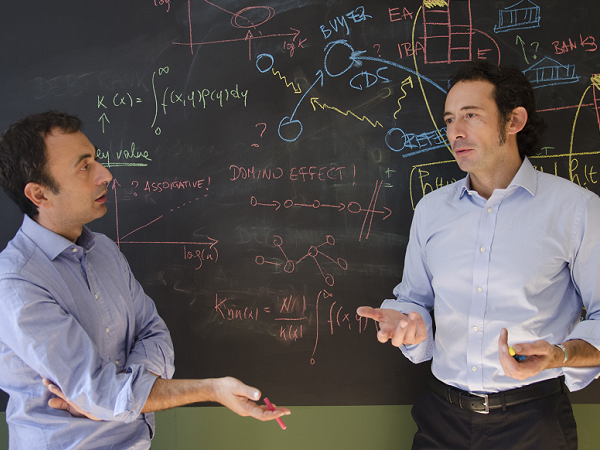Modelling the financial system as a network is a precondition to understanding and managing challenges of great relevance for society, including the containment of financial crises and the transition to a low-carbon economy.
Financial Networks is the scientific discipline that deals with these issues. An article published in the scientific journal Nature Review Physics, carries out the first comprehensive review of this exciting interdisciplinary field. By covering over 250 studies across domains, the paper is also a call for researchers in all scientific disciplines to consider the insights from the financial network models, because of their implications for citizens, public agencies and governments.
The study was coordinated by Professor Guido Caldarelli from Ca’ Foscari University of Venice. It is an interdisciplinary collaboration involving Professor Stefano Battiston from the Ca’ Foscari’s Department of Economics and six researchers from other international academic institutions. Notably, it is also a collaboration with the Bank of England, with the senior researcher Marco Bardoscia featuring as first author.
“Traditional economic models describe the financial system either as a macroeconomic aggregate or, in contrast, as a collection of microeconomic actors in isolation,” Stefano Battiston, co-author and professor of Economic Policy at the Department of Economics of Ca’ Foscari University of Venice, explains. “Both approaches do not take into account interconnectedness: financial actors are connected (directly and indirectly) via contracts, markets and institutions. As a result, traditional approaches are not well-equipped to describe theose phenomena that emerge at the intermediate scale, because of interconnectedness. These include, in particular, the propagation of risk along a chain of contracts (financial contagion), as well as the collective behaviour of investors when they stamped to get rid of assets suddenly deemed as more risky than expected (fire-sales).”
The discipline of financial networks has thus filled important scientific gaps. The importance of financial networks is widely recognised today. Many central banks use network models to carry out stress-tests. The highest financial authorities both in the US and in the EU follow macroprudential policies that recognise the key role of the interconnectedness of the financial system. Indeed, network effects played a key role in the 2007-2008 financial crisis, with an impact persisting for a decade, and they played a role also in the Covid crisis.
“There is something fascinating and special about the field of financial networks,” Guido Caldarelli, co-author of the study and professor of Physics at the Department of Molecular Sciences and Nanosystems of Ca’ Foscari, adds. “Questions that pertain to finance and economics are addressed by modelling financial actors as nodes and financial contracts as links in a network. For instance, the question of how to preserve the stability of the financial system is addressed by looking at the interplay between the network structure (i.e. the topology), the characteristics of individual nodes (the balance sheets) and the dynamic process on the nodes (the propagation of financial losses).”
This approach owes a great deal to the field of statistical physics which has been historically devoted to the challenge of explaining the emergence of macroscopic behaviour of a system from the microscopic properties of the individual entities. However, in financial networks, there are additional distinct features that raise the stakes of the challenge. The entities of the system are not particles, but agents that form expectations about the future evolution of the network and even about the policy maker’s attempt to regulate the system. This leads to new scientific questions in terms of the mathematical equations that can describe such reflexivity.
“In the near future, Financial Networks will address several exciting scientific challenges,” Guido Caldarelli foresees. “For example, modern financial systems are composed of multiple interacting networks because of agents acting on multiple markets with different instruments. Further, modelling the financial system poses big data issues as transactions generate Terabytes of information every day. Moreover, the interaction of the financial system with the real economy is a feedback loop and still not well-understood.”
One avenue of research of particular interest for Ca’ Foscari’s researchers is the application of financial networks in the area of sustainable finance. This area is relevant to the European policy context because the European Union has set the goal to become carbon-neutral by 2050. The transition to a carbon-neutral economy will avoid the most adverse impact of global warming on current and future generations.
The topic is particularly relevant for Italy because it relates to the recovery from the pandemic and future competitiveness. Indeed, an early and well-managed transition brings opportunities. In contrast, an ill-managed transition (for example, firstly delayed and then occurring in a sudden way) would involve higher systemic risks. In fact, financial institutions have large exposures to economic activities that are affected by climate policies. Therefore, financial network models are key to understanding how to facilitate the transition and mitigate climate-related financial risks.
In addition, the article demonstrates the relevance of financial networks not only for research but also for practitioners in financial authorities and in the industry. “Today, having competences in Financial Networks gives a competitive advantage to prospective students graduating both at a Master’s and PhD level.” professor Battiston adds. “Courses in this field will enrich the curricula of study not only in physics but also in economics and finance. This could apply also to future executive education programmes.”











